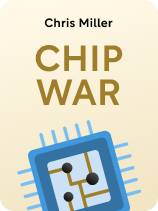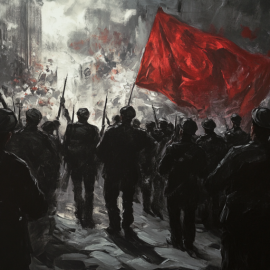

This article is an excerpt from the Shortform book guide to "Chip War" by Chris Miller. Shortform has the world's best summaries and analyses of books you should be reading.
Like this article? Sign up for a free trial here.
What Cold War technology emerged in the 1940s and 1950s? How did military investment influence the development of electronics?
Cold War technology centered on semiconductors and computer chips used for intelligence, guiding weaponry, and more. By understanding how the military influenced technological research and development, you can develop a better grasp of economic history.
Read on to learn more about how semiconductors developed through the Cold War.
The Birth of Semiconductors
The modern chip industry traces its origins to the immediate aftermath of World War II, when a small group of engineers and entrepreneurs realized the vast military potential of semiconductors. This represented a massive opportunity with the rise of the Cold War in the 1940s and 1950s and the resulting unprecedented demands of the American military for new technology.
In this article, we’ll explore Cold War technology including the discovery of semiconductors, the invention of the chip, its initial use in military and defense applications, and the rapid growth of the chip industry.
The Cold War Context
The Cold War was the backdrop—and ultimately the impetus—for the emergence of the semiconductor industry. After the devastation of World War II, the United States and the Soviet Union emerged as the world’s two military and geopolitical superpowers. Over the next half-century, the two nations and their respective allies and satellite states would wage the Cold War—a titanic ideological, economic, and political conflict.
The Cold War competition underscored the US military’s need for technology to guide its bombs, missiles, and eventually its satellites with precision. This is what ultimately drove the military’s insatiable appetite for computing power.
| The Military Push for New Technology After World War II The Cold War was one impetus for the US military’s massive investments in new technology after World War II, but there were other factors as well: Technological advancements in warfare: World War II had demonstrated the strategic importance of technological superiority in warfare. This led to a continuous push for innovations in military technology, including advanced weaponry, communication systems, and surveillance equipment. Industrial and economic factors: The defense industry played a significant role in the post-war US economy. The development and production of advanced military technology provided jobs and economic stimulus, motivating continued investment in defense research and development. |
Discovering the Power of Semiconductors
It was in this broader historical context that scientists discovered how semiconductors could be harnessed to spark a revolution in electronics. Semiconductors are materials that have electrical conductivity between that of a conductor (a material that allows the flow of electrons with minimal resistance) and an insulator (a material that blocks the flow of electrons). They’re crucial components in electronics, as their unique electrical properties can be manipulated to control the flow of electric current.
In 1947, William Shockley, an employee at Bell Labs, found that by having metal contacts make physical connections with semiconductors, he could create a transistor—a kind of electrical switch that could be turned on or off to regulate or amplify the flow of electricity in electronic circuits.
From Vacuum Tubes to Transistors
The transistor was a game-changer for military—and, later, civilian—electronics. Up to this point, vacuum tubes were the primary electronic components in military hardware. Vacuum tubes are glass or metal envelopes that contain no air or other gasses inside. The vacuum inside the tube helps prevent the interference of gas particles with the flow of electrons.
But they were far from ideal. Vacuum tubes were bulky, prone to malfunction, and physically large, limiting their potential, particularly in military contexts. Transistors, on the other hand, were significantly smaller, lighter, and more efficient and durable.
Following these discoveries, the 1950s saw a small group of engineers and entrepreneurs found the modern chip industry.
Doing Business With the Military
The timing could not have been more fortuitous for these early chip entrepreneurs. With the Cold War-era space race in full swing, the US government was determined to outcompete the Soviets in satellite technology and space exploration. In this context, NASA became a major buyer of Fairchild Semiconductor’s chips for guidance systems and satellites.
At the same time, TI was selling its chips to the US military for guided missile systems. TI’s success was due in no small part to the insights of Chinese-born engineer Morris Chang, whose efforts to refine and perfect the chip manufacturing process enabled TI to master the mass production and miniaturization of chips. Chang would later go on to play a leading role in the rise of the Taiwanese chip industry—a subject we’ll explore in more detail later in this guide.
| Defense Spending and the Postwar California Economy The military’s investment in semiconductor technology was just one part of a massive influx of defense spending after World War II that played an enormous role in shaping the modern American economy—and in particular, the economy of California, where the chip industry was taking root. In Fast Food Nation, Eric Schlosser notes that in Southern California, defense spending was responsible for $20 billion worth of investment in the region, as the federal government built airplane factories, steel mills, military bases, and naval ports. Indeed, writes Schlosser, federal spending accounted for approximately half of Southern Californians’ personal income. This growth would only continue, as California became a hub for the defense industry, with numerous defense contractors and military bases establishing a presence in the state. The aerospace and electronics sectors, in particular, flourished due to government contracts and research initiatives—leading to substantial job creation in California that attracted a diverse workforce from across the country. |

———End of Preview———
Like what you just read? Read the rest of the world's best book summary and analysis of Chris Miller's "Chip War" at Shortform.
Here's what you'll find in our full Chip War summary:
- The history and rise of the semiconductor industry in the US and abroad
- How national security became intertwined in the chip industry
- How a spurned TI employee grew the chip industry in Taiwan






